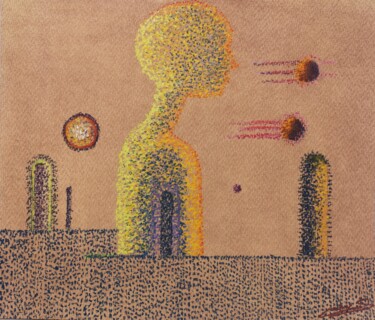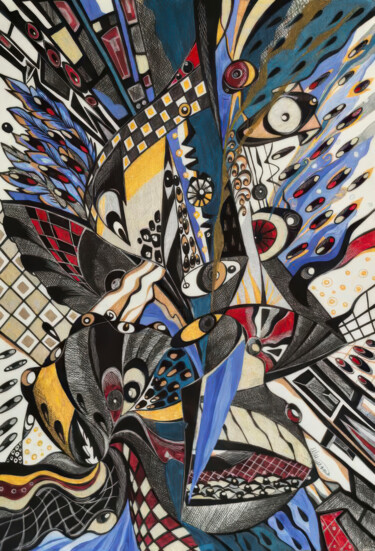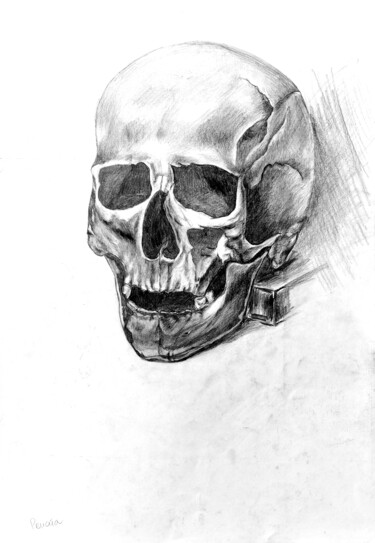212 販売のための元の図面とイラスト:
販売のための元の図面を探していますか?
現代アート、ストリートアート、抽象芸術、比喩的な芸術、風景、肖像画、人生のシーン、ヌード、鉛筆、インク、木炭、パステル…ArtMajeurは、芸術的で美しさを祝うすべての感性に応えます。 20年間、360万を超える現代美術作品を発見し、獲得することができます。芸術的なデザインの世界的なベンチマーク。世界中の現代アーティストの作品を見つけて、クラスでインテリアを飾りましょう!シンプルなアート愛好家または確認済みのコレクター?あなたの装飾を本当に際立たせる絵やお気に入りのスケッチを見つけてください。 ArtMajeurは、世界最高の現代アーティストによるオリジナル作品、限定版、アートプリントを提供しています。 ArtMajeurでは、ドローイングはアートマーケットの愛好家や専門家によって選ばれています。トレンディで受賞歴のある有名なデザイナーのオリジナル作品と、現代アートの分野で新たに高まっている価値観を選択して、アートドローイングをオンラインで購入するプロセスをガイドします。
Discover contemporary Technology Drawings on ArtMajeur
Contemporary Technology Drawings are a fascinating genre of original artwork that is gaining popularity in the modern world. They are created using a variety of supports and materials, including digital tablets, stylus pens, and specialized software. These works of art are unique in that they combine the precision and accuracy of digital technology with the creative vision of the artist.

©2025 Leni Smoragdova
Origins and History
Contemporary Technology Drawings emerged in the late 20th century as artists began exploring the relationship between technology and art. This movement was influenced by the rise of digital media and the computerization of design processes, which allowed for greater precision and control over artistic output.

©2017 Milto Sideris
Evolutions of theses works in the contemporary art market
Contemporary Technology Drawings have experienced a significant evolution in recent years. With the advent of digital technology, artists have been able to explore new ways of creating art, which has led to the emergence of new forms of drawing. These new forms range from computer-generated graphics to interactive installations and augmented reality experiences. The importance of these drawings in the contemporary art market cannot be overstated.

©2022 Cécile White
Related Famous Artists
Contemporary technology drawings have become increasingly popular over the last few years, and several artists have made a name for themselves in this field. One of the most well-known is Daniel Rozin, whose interactive installations use technology to create mesmerizing works that respond to the movements of the viewer. His "PomPom Mirror" is particularly noteworthy, as it uses 928 faux fur puffs to create a stunning, animated reflection.
Another artist who has gained recognition for her work with technology is Camille Utterback. Her interactive installations often involve projections and sensors that respond to the movements of the viewer, creating a unique and immersive experience. Her "Text Rain" piece, in which falling letters respond to the movements of the viewer, has become a classic of the genre.
A third artist who has made a mark in the world of contemporary technology drawings is Rafael Lozano-Hemmer. His work often involves large-scale installations that use technology to create a dialogue between the viewer and the artwork. His "Pulse Room" installation, for example, uses the heartbeats of visitors to control the lighting in the room, creating a unique and intimate experience.
Other notable artists in this field include Golan Levin, whose work often involves the intersection of technology and biology, and Zach Lieberman, whose interactive installations blur the line between the virtual and the physical world. Overall, the world of contemporary technology drawings is a vibrant and exciting one, with artists pushing the boundaries of what is possible with new technologies and techniques.

©2022 Cécile White
Notable contemporary Technology Drawings
"Untitled (Google Maps)" by Simon Weckert, 2020, is a performance artwork that involved the artist pulling a wagon full of smartphones through the streets of Berlin to create fake traffic jams on Google Maps. This work comments on our over-reliance on technology and how it can be manipulated.
"Trojan Room Coffee Pot" by Quentin Stafford-Fraser and Paul Jardetzky, 1991, is a historic artwork that depicts the first webcam ever created. The webcam was set up to monitor the coffee pot in a break room at the University of Cambridge. This artwork revolutionized the way we communicate and access information.
"Can You Hear Me?" by Rafael Lozano-Hemmer, 2002, is an interactive artwork that allows visitors to speak into a microphone and have their voice converted into a beam of light, which is projected onto a building. This work explores the relationship between technology, communication, and public space.
"The Clock" by Christian Marclay, 2010, is a video installation that features a 24-hour montage of film and television clips that depict or reference time. The work is synchronized with the actual time and is a commentary on the ways in which we perceive and measure time in our daily lives.
"Hello World!" by Chris Milk, 2011, is an interactive installation that features a robotic arm that writes "Hello World!" in sand. The arm is controlled by a computer algorithm that responds to social media messages. This work explores the relationship between technology, communication, and the natural world.
"Selfie Harm" by Rankin, 2019, is a photography project that features a series of portraits of young people who have been digitally altered to look like they have undergone plastic surgery. The work comments on the pressure that social media and technology place on individuals to conform to unrealistic beauty standards.
"Data-Drive" by Refik Anadol, 2019, is an art installation that uses artificial intelligence to generate abstract visuals based on data collected from the Los Angeles Philharmonic’s archives. This work explores the intersection of technology, data, and creativity.

Götz Wiedenroth
紙の鉛筆 | 8.3x11.4 in

Ivan Colas
紙のパステル | 11.8x13.8 in

Nolan Trace
紙のマーカー | 9.8x9.8 in

José Ignacio Gianola
紙のボールペン | 19.7x11.4 in

Nolan Trace
紙のマーカー | 9.8x9.8 in

Irina Shumskaya
紙のアクリル | 23.6x15.8 in

Nolan Trace
紙のマーカー | 9.8x9.8 in

Nolan Trace
紙のマーカー | 9.8x9.8 in




























